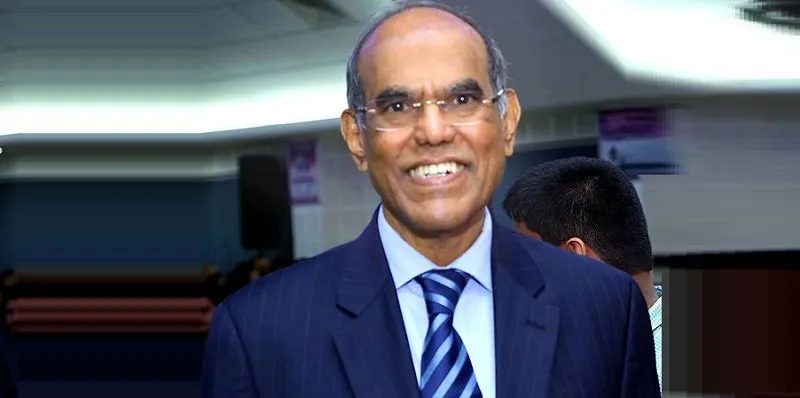'Time to be on guard' - D Subbarao, former RBI Governor
(Editor's note - This is the full text of former RBI governor D Subbarao's views on demonetisation)
The recent decision of the Government of India to delegalize high denomination currency was motivated, as per the press release issued by the Government to eliminate black money ‘which casts a long shadow of parallel economy on our real economy’ and to curb counterfeit currency, which is used to finance terrorism and drugs and as a conduit for money laundering.
The Government said that in place of the delegalized currency notes, it will introduce two notes in the denomination of 500 rupees and 2000 rupees, which will be distinctly different from the outgoing notes in size, design, colour and look.

In a poor economy where bulk of the ‘last mile transactions’ are done in cash, a measure like this was bound to cause fear and panic, and also scarcity of legal currency as people hoard it for safety-net purposes.
Anticipating this, the Government announced a host of measures to alleviate pain and hardship, including an opportunity to exchange up to Rs. 4000 of outlawed currency into legal currency, limiting cash withdrawals from banks and ATMs and to allow use of the delegalized currency for some emergency and urgent purposes for the first 72 hours after the measure came into effect.
There is also an open offer to people to deposit delegalized currency in their bank accounts without any limit for par value up to 31 December 2016.
In the one week since this stunning and unexpected decision by the Government, even as millions of households are struggling to cope with the immediate situation, there has been a lot of analysis and speculation on the stated and unstated motivation that prompted this move: the size of the black economy and how much of it might actually be hit by this measure, its impact on the macroeconomy in the short-term and the medium-term, the winners and losers and whether indeed its impact will endure after the initial flurry.
This essay attempts to take stock of this analysis.
Black Economy – How big is it?
Black economy is the market based production of goods and services – legal or illegal – that escapes capture in the official GDP statistics.
The tax that the government forfeits on this activity circulates as black money.
There are no reliable estimates of the blackeconomy. Most analysts – including ironically, the Indian Government – are relying on a World Bank estimate that put the size of the black economy for the year 2007 at 23.2 percent of GDP.
Assuming, albeit conservatively, that it would have grown to about a quarter of the GDP in the eight years since, a ball park estimate of the black economy on a GDP of USD 2 trillion would be USD 500 billion.
If this were taxed at 16 percent, which is the average tax incidence in the white economy, the tax loss to the governmentworks out to USD 80 billion (about Rs. 5 trillion).
How much of this black money will now come out into the open because of this delegalization of high denomination currency remains a matter of conjecture.
Anecdotally, much of the black money is held in land, property, stocks, gold or foreign currency. The impact of delegalization will depend, among other things, on the proportion of the black money that is held in cash. Even as it requires making some heroic assumptions, it may be worthwhile putting some numbers into these estimates.
Currency in circulation, as per the Reserve Bank of India (RBI) data, is USD 250 billion (Rs. 16.5 trillion) of which 1000 and 500 rupee notes constitute 85 percent (USD 212 billion or Rs. 14.0 trillion).
On the assumption that 75 percent of this money is returned to the banking system (either through cash exchange or deposit into accounts), about USD 160 billion or Rs. 10.5 trillion will return to the banking system, while the balance USD 52 billion (Rs. 3.5 trillion) – as much as 2.5 percent of the GDP - will be destroyed.
Intent behind Delegalization
Unearthing black money was a high profile issue in Prime Minister Narendra Modi’s platform as he campaigned for the 2014 parliamentary elections.
Since coming into office, the Government has instituted a number of measures, as indicated in its press release, to attack the menace of black money – setting up a Special Investigation Team (SIT), enacting a law governing undisclosed foreign income and assets, amending the Double Taxation Avoidance Agreements with Mauritius and Cyprus, reaching an understanding with Switzerland for getting information on bank accounts held by Indians with HSBC, encouraging the use of non-cash and digital payments, amending the Benami Transactions Act and implementing the Income Declaration Scheme 2016.
Notwithstanding all these efforts, the public perception has been that the Government has not succeeded in effectively hitting at the root of the problem.
Note that even the much publicized income disclosure scheme has resulted in disclosure of only Rs. 1.2 trillion.
Besides, there is also an impression that the big culprits are still able to escape the Government’s heightened enforcement.
On the other hand, currency in circulation has been growing rapidly - going up by 15 percent year on year since financial year 2015/16, significantly faster than the trend rate of 10.7 percent over the previous three years. In its Annual Report for 2015/16, the
Reserve Bank offered some possible reasons behind this spurt in cash – State elections, festival demand and a jewellers strike in April this year. What is surprising though is that unlike in the past, the currency did not revert to its trend level after the events.
Even increase in e-transactions does not sufficiently explain this increase in demand for currency, suggesting that some other dynamic was at play.
The Government’s surprise move was evidently in response to this uncharacteristic expansion of currency in circulation, clearly out of line with the pace of expansion of economic activity.
Even as the economic case for delegalization is strong, it is possible that there were also some political economy calculations that weighed with the Government.
It is common knowledge that unaccounted for cash, especially in high denominations, plays a big role in financing election expenditure beyond the authorized limits.
The Government may have decided to choke this avenue and cleanse the system ahead of the next round of State elections due in 2017.
Macroeconomic Impact
In the very short-term, delegalization may hurt growth. The squeeze in cash will constrain consumption.
Arguably, delegalization will also be disinflationary in as much as it cuts into non-discretionary consumption of items that go into the Consumer Price Index (CPI) basket.
The faster and more effectively the Government and the RBI are able to handle the transition, the less will be the adverse impact.
What is important, however, is the medium- to long-term macroeconomic implications, which are decidedly positive. As delegalized currency is deposited in banks and as new currency comes into circulation, some very positive dynamics will kick in.
By far the most important outcome will be that as the shadow economy merges with the formal economy, it will spur economic activity into a virtuous cycle.
This will be further buttressed by the ‘windfall’ deposits that banks will get which can be as high as 7.5 percent of GDP (see Table 1).
Banks will see their cost of funds declining even in the absence of any further policy easing by the RBI, and this should encourage them to reduce lending rates and pump credit into the economy.
Delegalization should also be disinflationary. At an aggregate level, the supply side response will raise production capacity and prevent overheating of the economy.
Moreover, real estate, which has been a safe haven for black money, will experience a squeeze.
Although property values do not enter the CPI consumption basket, its benign impact will come through decline in rental values and transmission of that into the general price level.
Government finances will improve as tax is levied and collected on the disclosed wealth which is reckoned as unaccounted. How big this will be is a matter of debate but there should be no doubt that the tax and enforcement agencies will scrutinize bank deposits with a hawk eye and come down ruthlessly on offenders.
A conservative estimate is that the Government will be able to mobilise additional tax of the order of 0.5 percent of GDP (Rs. 650 billion).
This will help fiscal consolidation, investment in infrastructure and in ‘crowding in’ private investment.
The ‘cleansing of the system’ will be positive for both savings and investment.
It will improve the ease of doing business, inspire investor confidence and raise productive capacity of the economy. Households, who have traditionally parked a bulk of their savings in physical assets like gold and dwellings, will now be positively biased towards financial savings which will have a significant multiplier impact on the economy.
Finally, the shift to electronic modes of transactions, engendered by the temporary squeeze in cash, may actually persist even after the cash position normalizes as people experience its safety, convenience and efficiency.
That will be a big positive for growth and curbing corruption.
Windfall Gain for the Reserve Bank of India, and for the Government?
An issue that has engaged analyst attention and also baffled them somewhat is how the Reserve Bank of India will reflect the changes brought upon by the delegalization in its balance sheet.
This is non-trivial, not only because of its implications for public finance but also for the autonomy of the RBI.
All currency issued by the RBI carries a promise by the Governor to pay the bearer a sum equivalent to the value of the currency. This is a legal obligation.
Curiously, neither the Government nor the RBI have actually used the term ‘demonetisation’.
The press release issued by the Government talks only about ‘cancelling the legal tender character’ of the high denomination notes, raising questions about whether they are drawing a fine distinction between delegalization and demonetisation.
To the extent the delegalized 1000 and 500 rupee notes are destroyed (i.e. not returned tothe banking system), the liability of the RBI should come down by that amount.
As indicated in Table 1 this is estimated to be of the order of Rs. 3.5 trillion.
Will the RBI treat ‘the promise to pay’ as a continuing liability and transfer an amount equivalent to the wealth destroyed to a special reserve? Or will it treat this as an extinguished liability and account for it as ‘profit’?
As required by law, profits of the RBI have to be transferred to the Government, and several questions arise in this respect.
(i) Can the RBI withdraw from its obligation to pay the bearer a sum equivalent to the value of the currency?
(ii) Is there therefore a subtle distinction between ‘cancelling the legal tender character of the currency’, the preferred phrase used by the Government and the RBI, and demonetisation?
(iii) If the Reserve Bank decides on treating the liability as extinguished, what is the cut-off date when it will happen?
(iv) How will the RBI treat the reduced liability – as a special reserve on which the Government has no claim or as regular profit which lawfully has to be transferred to the Government?
(v) If the existing law is unclear on this, will the Government amend the law so as to establish its claim to this money? (vi) If indeed, the ‘profit’ is to be
7 transferred to the Government, how will the transfer of such a large amount be managed?
In particular, how will it be phased out so that it is non-inflationary?
Can delegalisation be circumvented?
Over the last week, there has been much speculation on whether hoarders of unaccounted wealth stored in these high denomination notes circumvent the delegalization by converting it into gold or foreign currency.
In a country where people have been very innovative in operating at the fringes of law, there is no doubt that some people will try.
Already there are unverified media reports about an informal market for exchanging delegalized currency for legal currency at heavy discounts.
But the scope for such circumvention should be small if the Government can send out a harsh and credible message of ruthless penalties for infringing the law.
Is this Time Different?
The final question is whether the positive impact of this ‘draconian’ delegalization will last? After all, demonetisation or delegalization is not a new or original idea.
Several countries have tried it in the past; India too demonetized twice in the past – in 1946 and again in 1978. Global experience has been that demonetisation remained a one-time measure, and the black economy started building up all over again once the government lets its guard down.
This has been India’s experience too with the 1978 episode when the 10,000, 5,000 and 1,000 rupee notes were demonetized.
However, this time can be different for several reasons. In 1978, the value of currency demonetized was less than 2 percent of what was in circulation as compared to nearly 85 percent this time round.
Second, the significant advances in technology over the last 40 years will facilitate more effective audit trail of cash, making it difficult for hoarders to countenance a determined government.
Third, the expected launch of the Goods and Services Tax (GST), a few months down the line, one of whose chief characteristics is self-policing, should reduce the scope for the black economy.
Ultimately, it will be up to the Government to keep up the vigil, put fear into people transgressing the law through ruthless prosecution and bruising penalties and to curb corruption with a draconian hand.
The Modi government has both the challenge and opportunity o making this time, different.
About the author
Duvvuri Subbarao, former RBI Governor is currently Distinguished Visiting Fellow at the Institute of South Asian Studies (ISAS), an autonomous research institute at the National University of Singapore.







